2020 – an important year for celebrating Polish statehood
- Date of publication
- 3 March 2021
In 2020, celebrations related to regaining independence and rebuilding Polish statehood started with marking the 100thanniversary of Poland’s Wedding to the Sea: on 10 February 1920, General Józef Haller threw a wedding ring in the water in Puck, symbolically uniting the Second Republic with the Baltic Sea. The Baltic became Poland’s window on the world – access to the sea boosted the economic development of the rebuilding Polish state and consolidated its position in the international arena. Today, we cannot imagine that Poland could be any different – the Baltic Sea, its beaches, shells, dunes in the Słowiński National Park, the Polish fleet, fishing boats, the historic city of Gdynia with its modern harbours, the longest pier in Europe, and summer art festivals in seaside towns have become permanent parts of the landscape and character of the reborn Republic.
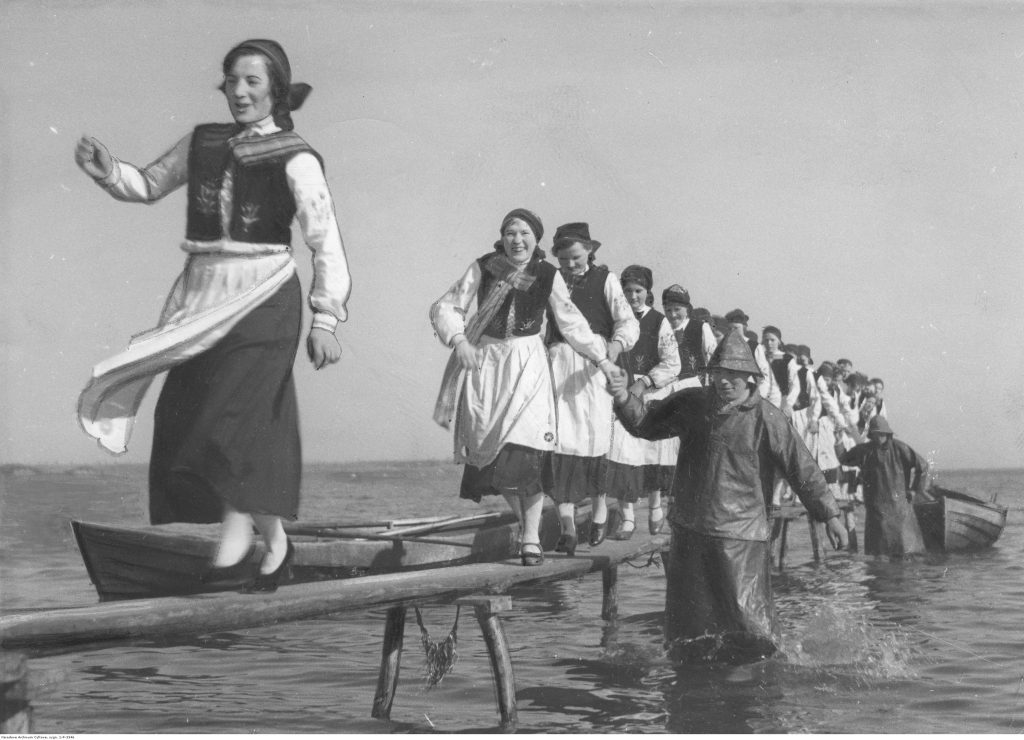
1. Girls in Kashubian costumes arriving by boat for the anniversary celebrations of Poland’s Wedding to the Sea, February 1938. Source: National Digital Archives online collection.
The Treaty of Versailles, which ended the First World War, was signed on 28 June 1919. Pursuant to the Treaty, part of Pomerania was incorporated into Poland, with access to the sea along a stretch of shore about 140 km in length, and Gdańsk was declared a Free City. Shortly afterwards, preparations started to take over the area from the Germans. Following the ratification of the Treaty of Versailles, Polish soldiers under the command of Józef Haller entered Pomerania. Starting on 17 January 1920, they moved northwards and finally held an official ceremony in Puck on 10 February. The Office of the “Niepodległa” Programme invited all Poles to jointly celebrate the 100thanniversary of the return of Pomerania’s towns and cities to the Republic of Poland.
One of the main attractions was the “Independent Poland” Virtual History Theatre Zone with 360-degree 3D VR screenings. Among the movies shown was “MS Piłsudski – ukryta historia”(“MS Piłsudski – a secret history”)about the legendary Polish ocean liner. Wearing special goggles, the audience was transported, with the help of virtual reality, to the deck of MS Piłsudski, which used to serve as a floating “embassy” of Polish culture, with its décor, furniture, crockery, works of art, and even ashtrays and menus produced and designed by Polish artists.
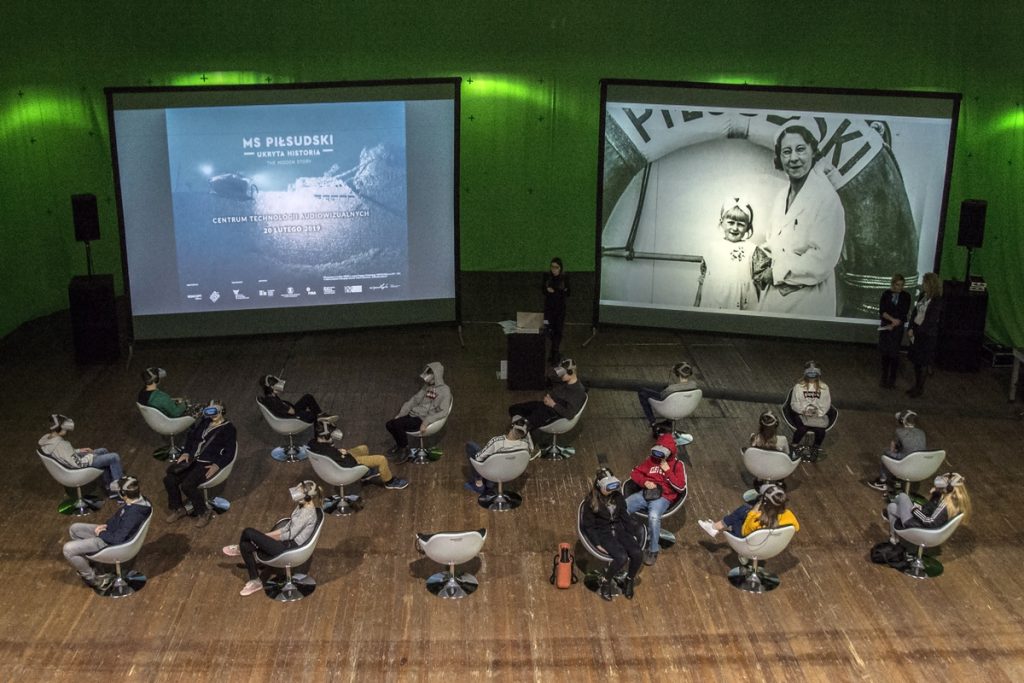
1. Picture from the premiere of the MS Piłsudski – a secret history VR movie
Seated in one of the 15 swivel chairs, after being greeted by the crew in themed costumes, audience members – wearing state-of-the-art VR devices and headphones – initially found themselves in a cinema room, watching an excerpt from an archive newsreel about the transatlantic liner. Then, unexpectedly, they would land on the deck of the Piłsudski,to be greeted by the legendary captain Mamert Stankiewicz. He was just one of the characters they met during that virtual journey – there were also Marshal Józef Piłsudski, Ignacy Jan Paderewski, and Thomas Woodrow Wilson. An important part of the show was the story of the development of Gdynia and of Poland’s wedding to the sea. Owing to archive photos and efforts by graphic designers, viewers could see the ocean liner both from inside and outside, from every possible angle. Archival films were also part of the show. The journey through the years when the Poles strived to bring their country back – not just on the map, but also in the world’s consciousness – ended in the present day, in the National Maritime Museum in Gdańsk, where viewers could, without getting up from their chairs, view display cabinets with original objects from the ship, thus arriving at the conclusion of this exceptional story.
The celebrations culminated with a concert at the Kashubian Philharmonic Hall in Wejherowo, which marked the centenary of Poland’s Wedding to the Sea. It was watched live by 350 viewers, including the President of the Republic of Poland and members of the Polish government, and nearly half a million people listened to the broadcast on the Trójka and Jedynka radio channels. Excellent Polish artists performed pieces with maritime themes.
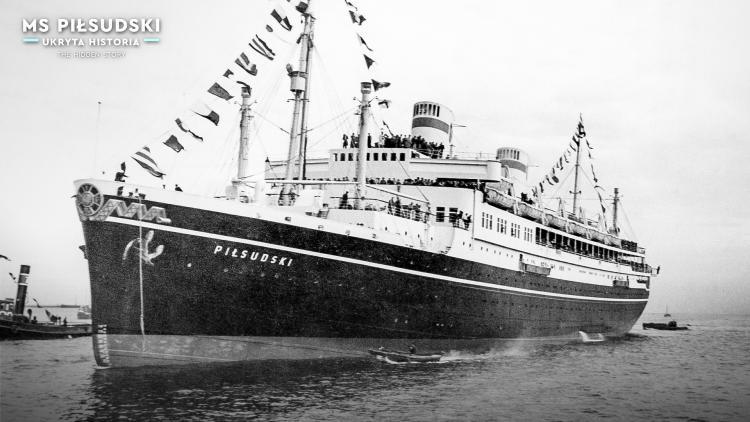
Legendary ocean liner MS Piłsudski
Shortly after those celebrations, however, 2020 posed huge challenges for cultural institutions around the world. The outbreak of the coronavirus pandemic brought the cultural sector to a standstill for many months and has permanently changed the manner in which institutions working in this area operate, highlighting the possibilities offered by the Internet in the process. Many consumers also discovered the attractions of browsing cultural heritage and have a good time in front of their computer.
Cultural institutions not only decided to make their resources available in a new way, but also joined the fight against the pandemic itself. Costume makers at theatres started to sew protective masks, and many cultural institutions developed educational materials to help children, forced to stay at home, to pass the time. A number of initiatives were also undertaken to help students prepare for their exams. Grassroots outreach programmes started, targeting the elderly and those who had to self-isolate in their homes.
On its website, the Office of the “Niepodległa” Programme launched a special map – the Chronicle of Kindness, where anyone could post an initiative related to the coronavirus pandemic. On that map, individuals who offered to do shopping, deliver hot meals or walk dogs for those self-isolating, the elderly or those at increased risk from the coronavirus, left their contact details. There was also no shortage of posts by formal associations that provide assistance on a daily basis but expanded their activities in the face of the pandemic or needed new volunteers.
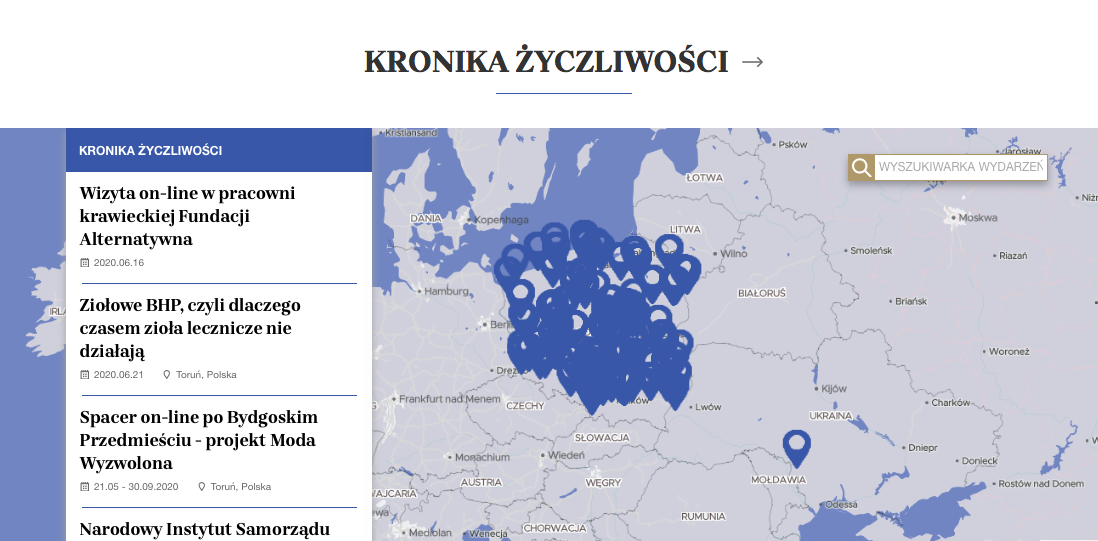
Photograph showing the Chronicle of Kindness with a map of events on the niepodlegla.gov.pl website
The Chronicle of Kindness became a bulletin board for local communities, and at the same time an inspiration, showing people how to organise in their own communities – neighbourhoods, families, cities – the kind of help that each of us can provide: simple gestures, tender words, as well as great initiatives.
Today, the Chronicle of Kindness is an initiative that documents the support we have given to each other, showing the great solidarity between people and demonstrating that a crisis can have a positive face to it as well. The Chronicle of Kindness proves how many big-hearted people there are, how much kindness there is around us and that we are united by the fundamental values we share.
Therefore, the Office of the “Niepodległa” Programme, together with Polish music stars, developed a project to remind us that even during a pandemic that makes us anxious, and despite the need to maintain physical distance, we are still united and will pull through these difficult times together. Together with well-known Polish artists, we composed and performed the song Wszystko będzie dobrze (“Everything will be fine”).
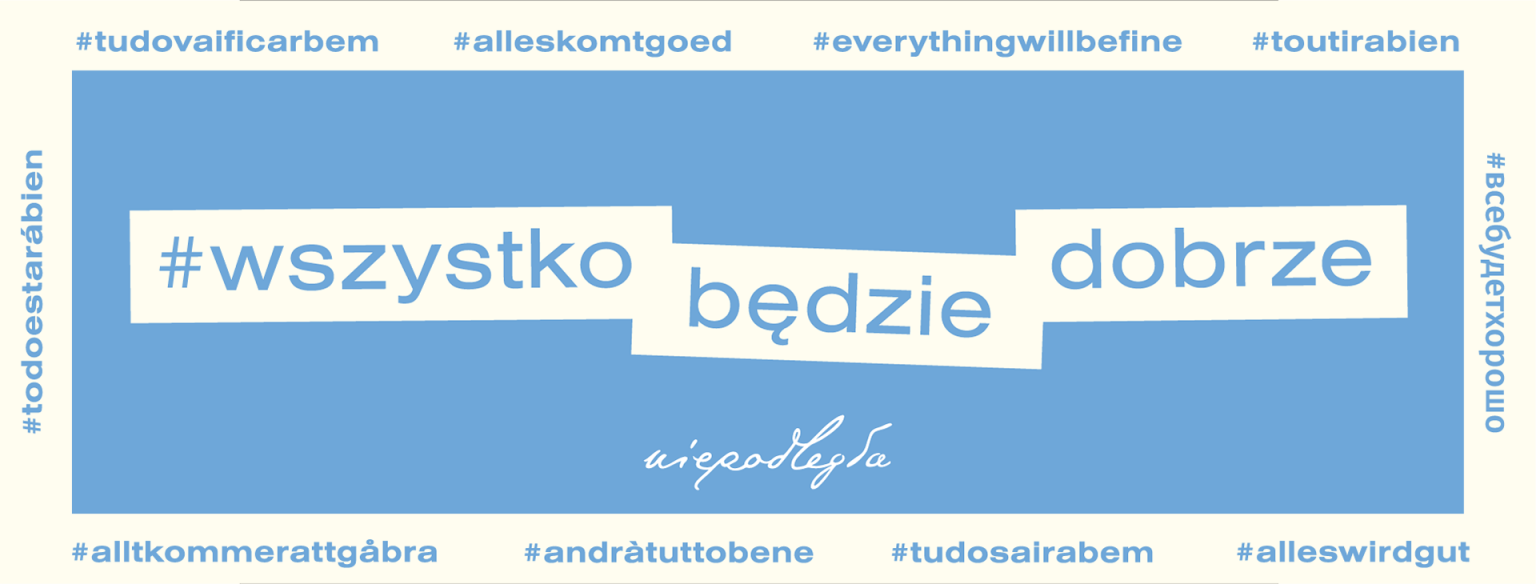
Event banner with the words “Wszystko będzie dobrze” (“Everything Will Be Fine”) in the middle
The purpose was to support all those who cared for our health – medical professionals, emergency workers, doctors, lab technicians, epidemiologists as well as all those unsung heroes whose work is equally important: police officers, shop assistants, volunteers, neighbours helping one another, and those who simply stayed at home, consistently following the instructions to prevent the spread of the pandemic. Everyone could download an instrumental version of the song and record their own rendering at home to share it on social media with the #wszystkobędziedobrze (#everythingwillbefine) hashtag.
During that anxious time, we were reassured by John Paul II. While celebrating the centenary of the birth of the Polish Pope, we recalled the messages of his pontificate. On that occasion, the Office of the “Niepodległa” Programme prepared a unique musical show with the participation of well-known Polish artists. It was broadcast on our website and YouTube channel, as well as by public and private TV stations, and also on the Jedynka radio channel. The concert was interpreted in the Polish Sign Language, and audio description was also available.
The show was prepared and performed in accordance with social distancing rules. Some of the pieces were pre-recorded, and during the concert they were displayed on large screens placed in the Sanctuary of St. John Paul II in Kraków, creating an impression that the performers were on stage.
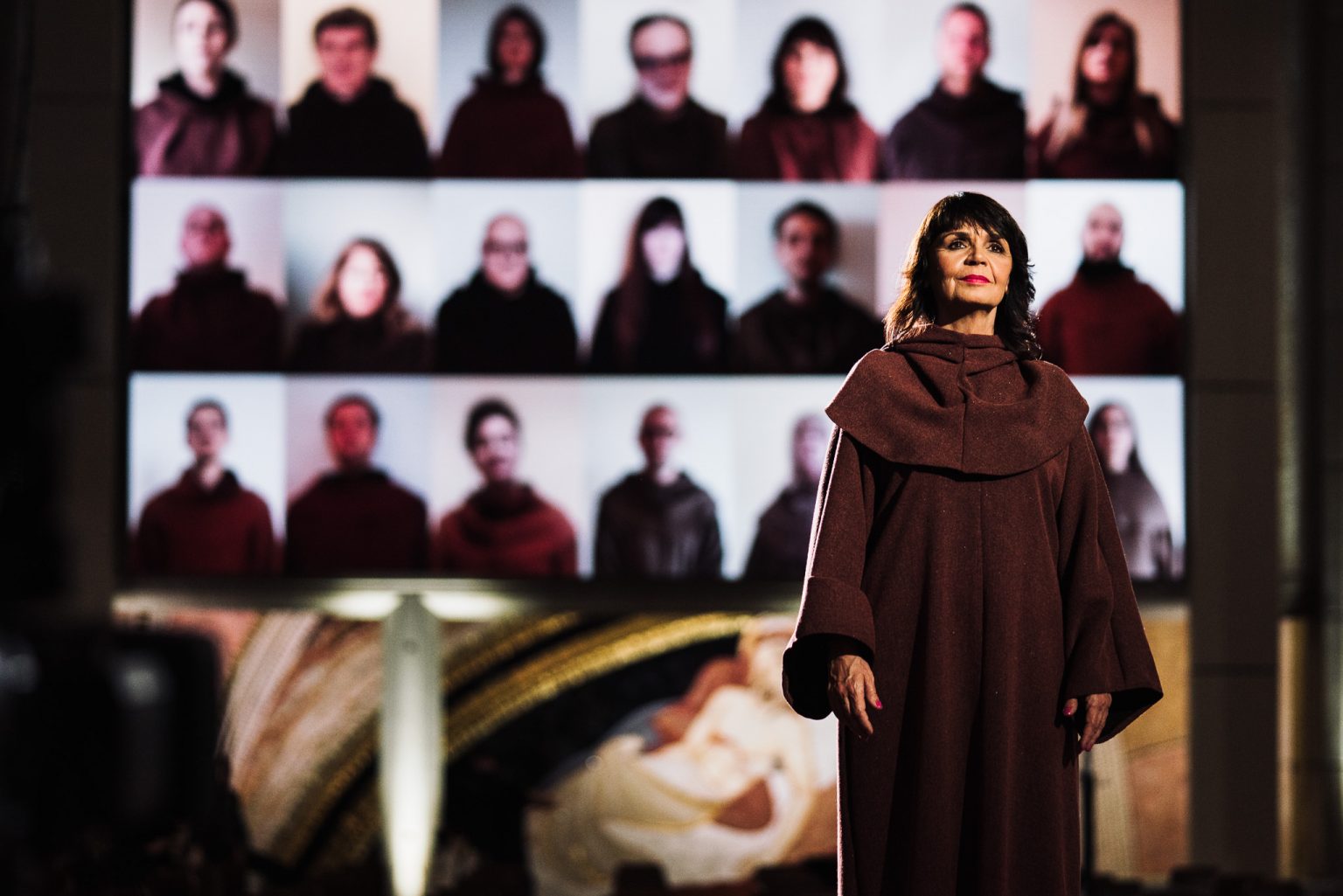
Photos from the production of the “Santo Subito” show on the occasion of the centenary of the birth of John Paul II, photo: Tomasz Tołłoczko / Office of the “Niepodległa” Programme
To commemorate the 100thbirthday of the Polish Pope, the Office of the “Niepodległa” Programme also produced an extensive collection of information resources for those wishing to learn more about the life of Saint John Paul II: the film Świat według Jana Pawła II(“The World According to John Paul II”) was produced in collaboration with the Polish Television, and a podcast – a conversation with Father Mateusz Hosaja about the Pope’s life and pontificate entitled “Wydarzyło się 100 lat temu” (“It Happened 100 Years Ago”) – was produced in collaboration with the “Rzeczpospolita” daily.
The summer season, as usual, was full of events held in the “Independent Poland. A Meeting Place” cultural pavilion run by the Office of the “Niepodległa” Programme in the Royal Łazienki Park. Throughout 2019, for instance, the pavilion had hosted free family workshops where participants could learn about the times of King Stanisław August Poniatowski, listen to stories about the scientific and technological achievements of the interwar period, or learn traditional Polish dances. 2020 brought new and unexpected challenges, so we prepared suggestions for workshops that could be organised at home – the “Retro Play Cards” proved a huge hit and entertained kids throughout the summer holidays.
The cards enabled children to discover how their peers used to play and spend their free time 100 years ago. The ideas for cards were sourced from original how-to books from the interwar period.
Each Monday from 1 June until 31 August 2020, we published a new set of four cards. Each set included instructions for word games, games involving movement, and for craft activities. The fourth task was always a creative surprise. Most of the materials required could be found in home cupboards. The suggestions on the cards were selected so that they would be suitable for children as young as four with some help from their parents or carers.
The retro play cards encouraged learning Polish history in a creative way, through play.
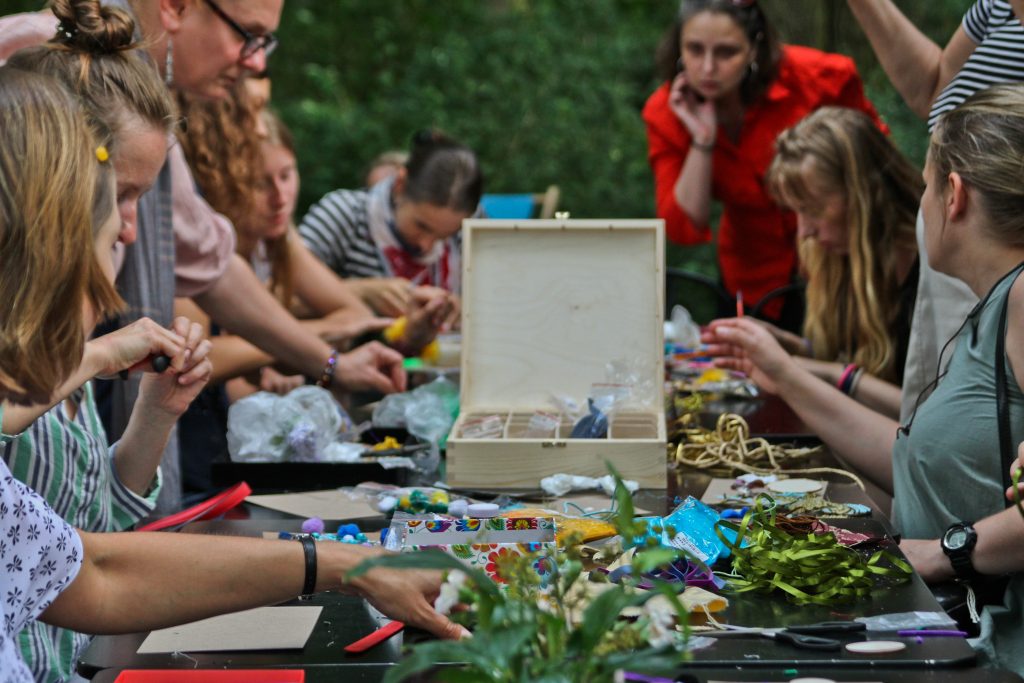
1. Handicraft workshops, photo: Kamila Szuba / Office of the “Niepodległa” Programme
Celebrations of the centenary of the Battle of Warsaw were also held in special circumstances. Due to the coronavirus pandemic and restrictions on gatherings, many events had to be planned anew, in a virtual format and with a smaller audience or no audience at all. In spite of this, or perhaps owing to that, everyone had the opportunity to take part in the joyful celebrations, and those interested could learn more about the events that took place a hundred years ago.
The projects developed by the Office of the “Niepodległa” Programme were very diverse so that everyone could have an opportunity to join in the celebrations in the way they liked. Those included a campaign that involved looking for, and sharing, memorabilia, the production of a VR film about the events of 1920, the development of a special information portal dedicated to the Battle of Warsaw, and many other initiatives.
First, a month before the 100thanniversary of the Battle of Warsaw, the www.bitwa1920.gov.pl multimedia portal was launched in seven languages. The modern website was created as a result of cooperation between two institutions – the Office of the “Niepodległa” Programme and the Polish Radio. It is targeted at those who simply want to find out why the Battle of Warsaw was dubbed “the Miracle on the Vistula”, but also at people who are passionate about history. We put an emphasis on multimedia, infographics, and user interaction. The narrative is intended to allow visitors to feel the atmosphere prevalent in Poland, Europe, and the world a hundred years ago. The website includes more than 30 unique recordings, some of which come from the archives of the Polish Radio and the Polish desk of Radio Free Europe.
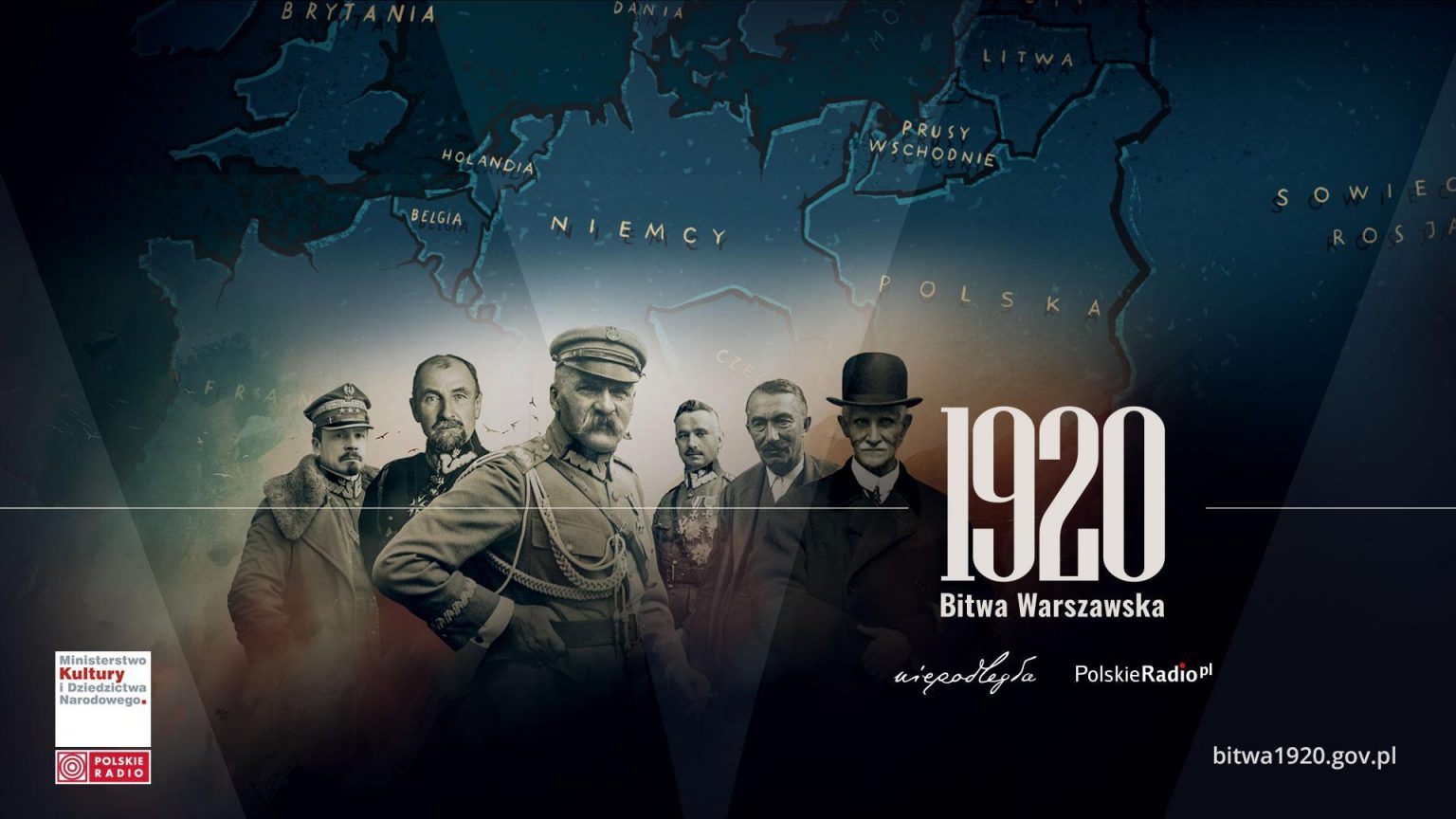
Graphic promoting a portal dedicated to the 1920 Battle of Warsaw
Our story is intended for audiences both at home and abroad, with the website available in Polish, English, German, French, Russian, Ukrainian, and Hungarian. The last two language versions are also meant to honour the most important Polish allies at the time of the Bolshevik onslaught. It should be remembered that it was the Ukrainians who were Poland’s largest allied army, and that in the dramatic days of August 1920, the Hungarians provided Poles with millions of rounds of ammunition.
We are extremely proud of the Wiktoria 1920 (“Victory of 1920”) feature film shot using cinematic VR, which uses innovative technologies to transport viewers back in time to see the Battle of Warsaw. The story depicts the role of intelligence (including signals intelligence), which gave the Polish army staff access to the enemy’s plans, making the victorious campaign of August 1920 possible. During the filming, cameras captured images from all angles, letting the viewer choose what they want to focus their attention on. To date, feature films of this type have been rare, mainly because they are more difficult to produce.
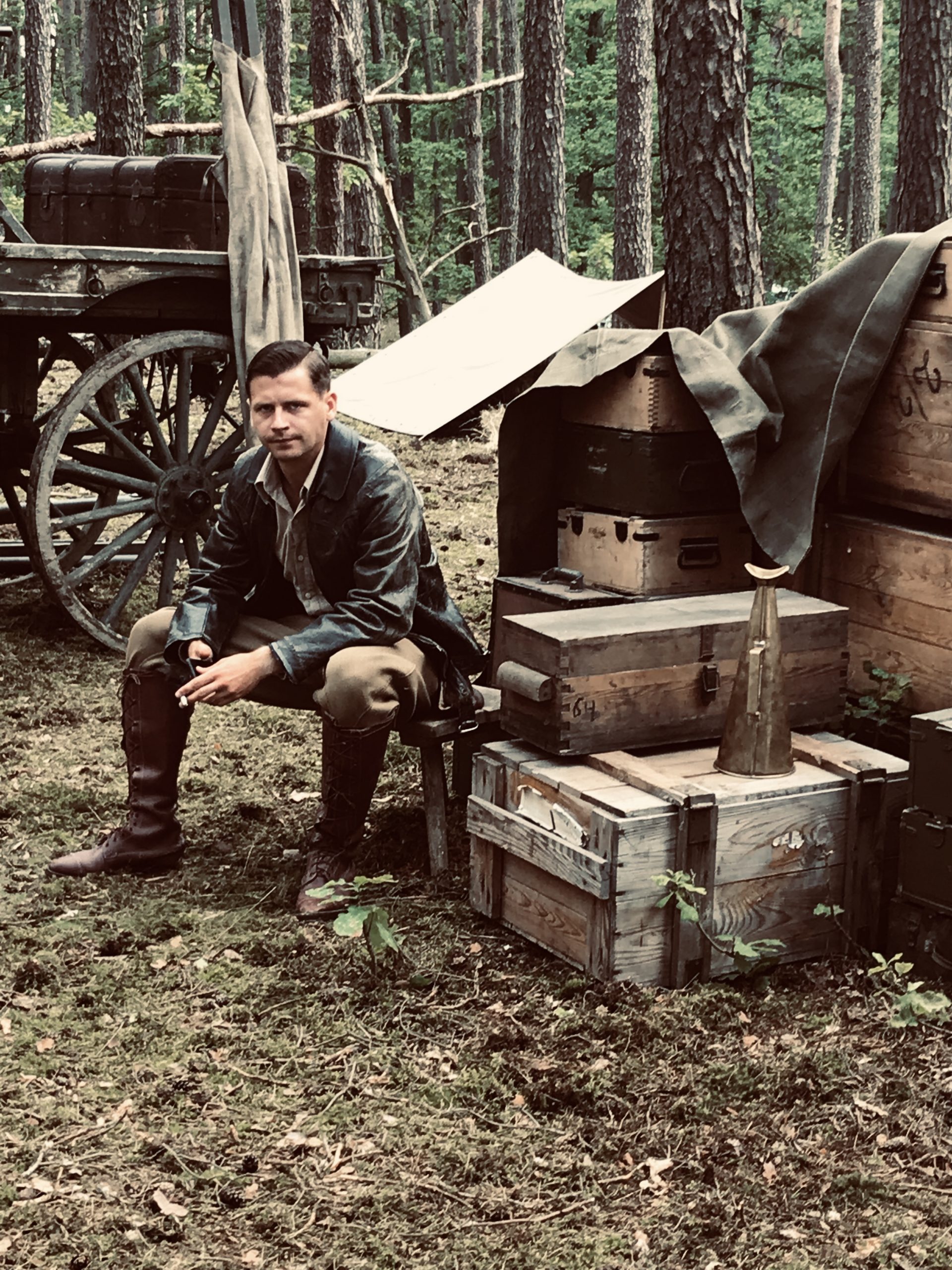
Still from the set of the Wiktoria 1920 (“Victory of 1920”) movie, showing Patryk Szwichtenberg who plays Merian C. Cooper, photo: Anna Bińkowska / Office of the “Niepodległa” Programme
In the Polish language version, the 3D filmcan be viewed for free on the “Niepodległa” YouTube channel. The best way to do this is to use simple Google Cardboards or VR goggles into which the viewer’s own mobile phone can be inserted. The film can also be viewed using Oculus or other types of VR headsets by going to the YT website and selecting the appropriate video settings. “Victory of 1920” can be viewedin a traditional 2D version as well,even on a desktop computer, where the viewer decides from which angle to look by using a mouse or touchpad. The English version will soon be available as well.
Another project implemented, among others, by the Office of the “Niepodległa” Programme on the occasion of the 100thanniversary of the Battle of Warsaw was the “1920. We are Grateful to the Heroes” show. The PGE National Stadium in Warsaw was transformed into a battlefield with Polish and Bolshevik trenches, and a stage in the middle. Apart from famous Polish artists, dozens of horses and hundreds of extras took part in the spectacle. The purpose was to present the history of the past century in a modern, attractive and entertaining way while also commemorating the heroes who fought for a free Poland. The show was watched by 40,000 spectators in the stands of the stadium, and by 2 million TV viewers on 15 August and on the following days when it was re-broadcast. Additionally, the performances could be listened to on public radio stations.

“1920. We are Grateful to the Heroes” show. Photo: Jędrzej Sokołowski / Office of the “Niepodległa” Programme
On 16 August 2020, a unique documentary premiered. Wojna Światów (“War of the Worlds”) takes viewers on an 80-minute journey through time. It is an epic story based on reconstructed and colourised archival films and told by the voices of those who participated in, and witnessed, the events of 1920. Although 100 years have passed already, many original (and often unknown) accounts of the participants and witnesses of the hostilities, unique archival films, photographs, orders, deciphered secret reports, diaries, and radio recordings have survived to date. Many of such materials, sourced from archives around the world, have been reconstructed, colourised, and assembled into a story. When necessary, the narrative is supported by historical re-enactments and computer graphics.The film was made available online free of charge and was released on DVD in December.
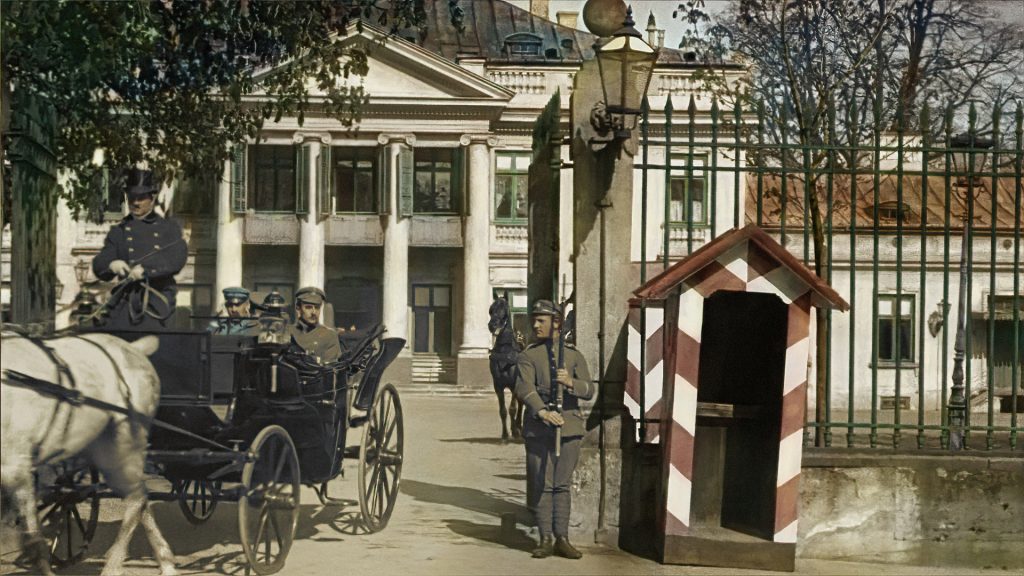
Józef Piłsudski in front of the Belvedere. Still from the Wojna światów (“War of the Worlds”) movie. Photo: press materials
History buffs were also able to follow the course of the Polish-Bolshevik war week by week. For more than half a year, the Office of the “Niepodległa” Programme together with the KARTA Centre ran a historical educational series “Wiktoria 1920 – zapiski z czasów wojny” (“Victory of 1920 – Wartime Notes”). Every week, historical accounts from one hundred years ago were published in the national press and online: on the “Niepodległa” programme website and on historical portals. Each of the 31 episodes contained letters, memoirs, official notes, proclamations and press clippings as well as entries from diaries which were written in 1920 and have never been published before. All those materials were complemented by unique photographs from the archives. Subsequent episodes of the series were published once a week from 17 April to 13 November.
For history aficionados, in collaboration with the Polish Radio, we also prepared special programmes devoted to the chronicle, and together with Radio Wnet we made a series of broadcasts devoted to the events of 1920. Together with the “Rzeczpospolita” daily, we produced a series of podcasts entitled Wydarzyło się 100 lat temu (“It Happened 100 Years Ago”).
Our website also included a special feature entitled Ksiądz Ignacy Skorupka – bohater Bitwy Warszawskiej 1920 (“Father Ignacy Skorupka – hero of the 1920 Battle of Warsaw”), elaborated in cooperation with the “Ossów – Gate to the 1920 Battle of Warsaw” project run by the local government. The presentation was complemented by 3D models of the most important exhibits, interactive views of places connected with Father Ignacy Skorupka’s life, and by the “We Saved Europe 1920” exhibition.
Those with writing talents were invited to compete in the “1920” literary contest, which was intended as a unique journey to the year of the battle. Various genres were considered eligible – crime stories, spy stories, stories of manners, etc. – but the condition was that they should refer directly to the events of 1920. Apart from financial awards, the winning authors may expect their stories to be included in a special collection, to be published by the Office of the “Niepodległa” Programme in 2021. We received almost 400 entries, from among which selection will be made for the anthology.
As part of a special edition of the “Coalitions for Independent Poland – Victory of 1920” grant scheme, nearly 160 institutions across the country received funding for local and regional initiatives commemorating the Polish-Bolshevik War. Local cultural institutions and NGOs pledged to prepare more than 350 events commemorating the Battle of Warsaw and the entire Polish-Bolshevik war throughout 2020. PLN 4.5 million was earmarked for the scheme.
Some of the initiatives devoted to the Battle of Warsaw were also implemented as part of the second grant scheme – “Niepodległa” (“Independent Poland”). A total of 116 projects on various subjects were funded, for a total amount of nearly PLN 6 million.
Additionally, the “Niepodległa” programme encouraged all Poles to search for traces of the Battle of Warsaw in their own neighbourhood. Those could include family memorabilia, photographs, old documents and letters, everyday objects handed down from generation to generation, monuments, unique locations, monuments or street names reminiscent of the events of the Polish-Bolshevik war, and even associations with the number 1920 – the time as displayed on a watch, or a scale indicating 19.20 kg. You only have to look around to realise that we are surrounded by more memories of the past than we might expect! We looked together for such traces from a century ago and collected them in the form of photos on social media with the #Wiktoria1920 (#VictoryOf1920) hashtag.
The last ceremony in 2020 related to the centenary of the Battle of Warsaw took place Skierniewice, where the “Before the Battle of Warsaw – Skierniewice 1920–2020” monument was unveiled; it commemorates the cooperation between Poland, France, Ukraine, and Hungary in the fight against Bolshevism during the Polish-Bolshevik War. Apart from Józef Piłsudski, it depicts Hungarian Prime Minister Pál Teleki, Ukrainian Commander-in-Chief and President of Ukraine in 1919–1921 Symon Petliura, and Charles de Gaulle – representatives of the European nations that showed solidarity by helping Poland fight Bolshevik Russia.
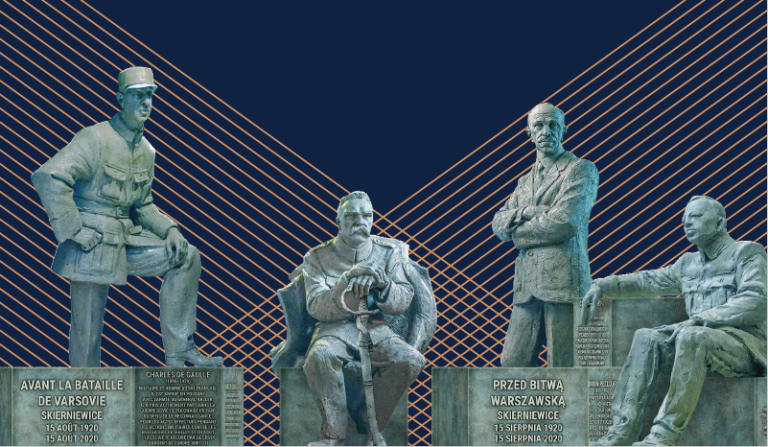
Visualisation of the monument in Skierniewice
The monument refers directly to the event that affected the course of the Battle of Warsaw. On 12 August 1920, the first train full of ammunition from Hungary pulled into the Skierniewice train station. The ally delivered millions of cartridges, artillery rounds, thousands of rifles and other military equipment, supplementing Polish supplies that were running low at the time.
The monument also recalls the Polish-Ukrainian alliance of that time, as a result of which 20,000 Ukrainian soldiers fought alongside Poland, as well as the advice offered to Poland by France and the role of Charles de Gaulle himself, who was member of a Polish combat unit in July and August 1920.
The most important message, which is the Poles’ gratitude to Hungarians, Ukrainians and the French for their help, is expressed by the inscription in four languages.
Simultaneously with the celebration of the 100thanniversary of the Battle of Warsaw, we continued our preparations for the celebration of the 102ndanniversary of Poland’s independence. As a result of the pandemic, our previous initiatives had to be modified.
At noon on 11 November each year, Poles used to sing the national anthem together in hundreds of places around the world. This time, we encouraged them to sing the Mazurek Dąbrowskiego (“Dąbrowski’s Mazurka”) with their families or flatmates, i.e. people they share their everyday life with. In that task, we were helped by radio and TV stations, which broadcast the anthem at noon, assisting those who did not feel up to the task of singing it a capella, but also by schools that taught children to sing and play the Mazurka on various instruments.
In 2020, families could also take part in the Niepodległa Festival in Krakowskie Przedmieście, which used to be an event exclusively for the residents of Warsaw and those who visited the capital at the time. This time, thanks to online coverage, anyone could join. The concert featured some of the most recognisable Polish artists. Additionally, activities and concerts for children were organised, and during the broadcast, scenes from five selected places in Krakowskie Przedmieście were shown to remind us of the atmosphere of previous festivals. The event ended with a Party for Independent Poland – we learned Polish dances together, and since we were all at home, this could be done in accordance with the sanitary regime.
Also the 160thbirthday anniversary of the first Prime Minister of independent Poland Ignacy Jan Paderewski was celebrated in unusual circumstances. No audience was present during the exceptional Kulka/Paderewski/Kulkaconcert, but the event was broadcast online directly from the Polish Theatre. Together with a group of invited musicians, classical violinist Konstanty Andrzej Kulka and his daughter pianist, composer and singer Gaba Kulka performed some of the most interesting pieces composed by Paderewski. The recording of the concert is still available at niepodlegla.gov.pl.
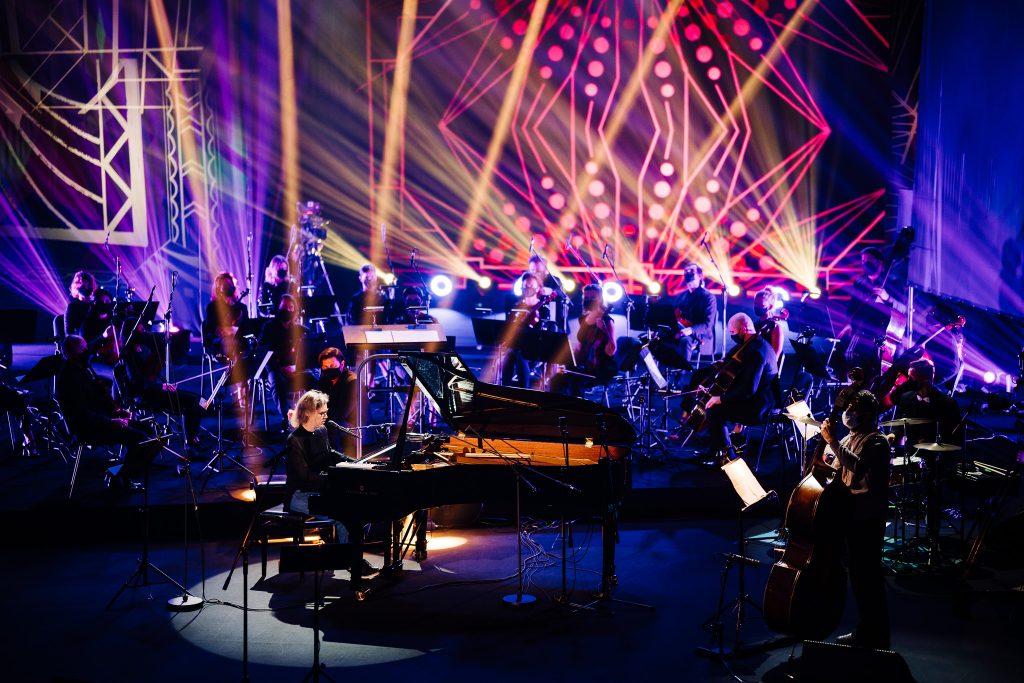
Kulka/Paderewski/Kulka concert, photo: Tomasz Tołłoczko / Office of the “Niepodległa” Programme
Additionally, we ran an educational and information campaign promoting the project that presented the life and work of Ignacy Jan Paderewski, which included a TV broadcast of the musical Virtuosostaged at the Musical Theatre in Poznań.
We also celebrated the year of Jan Kowalewski – a cryptologist from Łódź and lieutenant colonel in the Polish Army whose life may still serve as an inspiration today. We conducted information and educational campaigns to commemorate the hero who broke Russian ciphers during the Polish-Bolshevik War. At the “Independent Poland. A Meeting Place” cultural pavilion, a family picnic devoted to Jan Kowalewski was organised: participants could take part in creative family workshops, attend a meeting with a historian, see a monodrama about Jan Kowalewski and participate in a guided tour of the “Contribution of Łódź Residents to Independent Poland” exhibition.
The “Independent Poland. A Meeting Place” cultural pavilion also hosted the “Battle of Warsaw and its Significance” historical debate and another one dedicated to the celebration of 11 November, as well asa series of eight outdoor screenings of Polish films from the interwar period, which were organised in cooperation with the National Film Archive – Audiovisual Institute. The anniversary of the outbreak of the Warsaw Uprising was celebrated with the performance of insurgent songs by the Ferajna z Hoovera band, which was broadcast online.
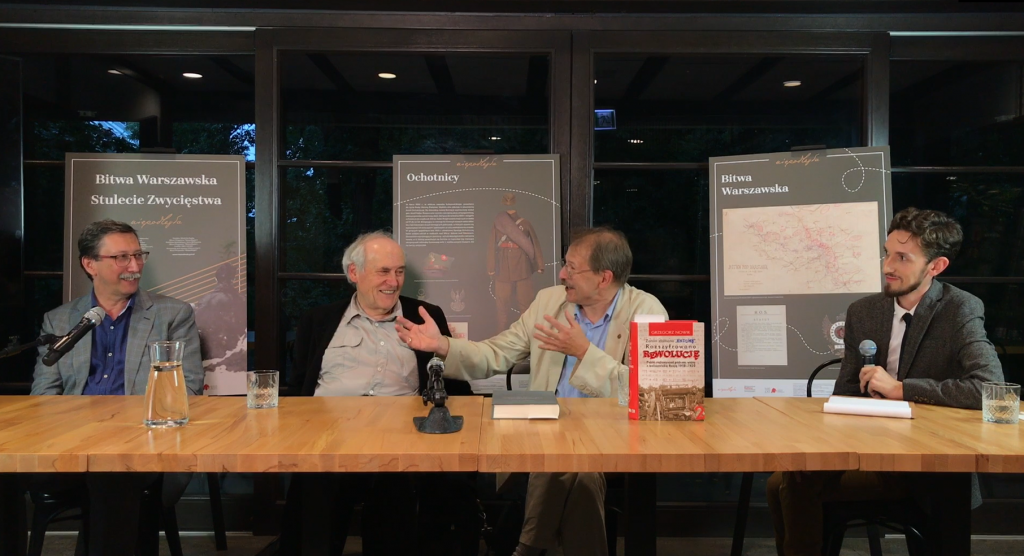
Photo from the historical debate on the 1920 Battle of Warsaw
In addition, we produced many educational materials to be freely used at home, in schools, in remote learning, at community centres, municipal institutions and other places. These have been downloaded hundreds of times and are used nationwide as learning aids and also as part of standalone exhibitions in public places.
The online format has proven successful and broadened our audience, so we know that it will remain in place after the pandemic as well because it gives more viewers the opportunity to participate in cultural events. However, we are also aware that nothing can replace live interactions with artists and the opportunity to experience emotions together with other people in cinemas and concert halls or outdoors – celebrating in a large group creates a unique atmosphere which we miss and which we yearn for, so if this proves possible next year, at least on a small scale, we will try to conduct our activities in a dual format – both online and in cultural institutions or in urban spaces and squares. We hope that future artistic seasons will allow us to celebrate together the subsequent anniversaries of events from Poland’s rich history.